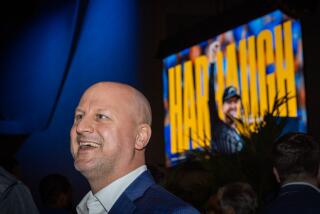It’s Chargers’ Day to Be a Big, Happy Family
- Share via
SAN DIEGO — Let’s see now, we have had months of America’s Cup racing, another Socker championship, the Padres living in the suburbs of a pennant race, the demise of the Sockers’ league, all the ballyhoo about the All-Star game and, finally . . .
Football is back.
And you thought the Chargers had gone into permanent hibernation.
There they were, however, in all their splendor Saturday afternoon at UCSD. As Jerry Coleman might exult, football under the sun. More accurately, it was football under a baking hot sun, with a few gallons of humidity tossed in.
The Chargers, who open their exhibition season next week at Phoenix, must have felt as if they were already there. They had to be wishing they had taken up water polo or become refrigerator inspectors for 7-Eleven.
Appropriately, it was billed as Family Day, which meant, essentially, that this was the last day families could afford to see the Chargers in person. Plenty of good seats are available for the 1992 season, as we were reminded with some frequency Saturday, but you have to sell your firstborn and bring the others.
Saturday was a freebie, parking and all. What’s more, you could get a soft drink and a hot dog for a mere $2, making it a bargain lunch even if you didn’t want to stay around and watch the football part of it.
Fans brought their coolers and burn ointment and sprawled on the grass, broiled in the concrete stands and perched on the hillsides. Like an efficient offense, they seemed to adjust to what was given them. Attendance was somewhere between 1,000 and 100,000, though I am inclined to favor the lower end of the spectrum.
It might be noted here that Al Davis, often suspected hereabouts of espionage, was detained elsewhere and was not among those lurking in the trees. A couple of radar-equipped spy planes did fly overhead. In Don Coryell’s days, he would have had a lackey check them for silver-and-black markings.
This was such a chummy event, in fact, that the players even came to the sidelines and signed autographs in the aftermath. The only one who did not participate was Joe Phillips, that being because Bobby Beathard has not been able to secure his autograph on a contract. Joe, who has the audacity to think he should make what a utility infielder makes, will not be a freebie.
The sparring partners on this occasion were the Anaheim Rams, who probably ranked third behind Mater Dei High School and Cal State Fullerton in Orange County last year. It might have been said the Rams went south with their 3-13 record in 1991, but it would have been superfluous. The Chargers were already there with their 4-12 record.
Between them, these two teams did not win enough games to qualify for the 1991 playoffs. Thus, they were able to sustain UCSD’s policy of not having a football team on campus.
Mind you, big things are being expected of these 1992 Chargers. OK, not big things. Bigger things.
Some folks have even suggested that the word playoff, as ridiculous as it may seem, might be reintroduced in San Diego schools for the first time in almost a generation of students. They say this is part because the Chargers play a chocolate eclair schedule that includes two portions of Indianapolis. What they neglect to consider is that folks in Indiana are probably relishing the thought of getting fat on two helpings of Chargers.
A scrimmage such as this is surely inconclusive in terms of evaluating what might be expected of these Chargers.
We know, of course, that they are friendly fellows who know how to spell their own names.
We know also that they are friendly fellows on the field, because we notice that the defensive players hold hands with one another in the huddle. I forgot to note whether they also hold hands on the sidelines and when walking to and from the locker room. I did notice that Leslie O’Neal and Burt Grossman never held hands with each other.
What we don’t know about the defense is whether it can hold opposing offenses as well as it holds hands. It did do pretty well against the Rams until nasty old Chuck Knox realized a healthy Flipper Anderson could outrun a gimpy Gill Byrd. Thereafter, Byrd was a species in danger.
Perhaps the safest conclusion to come from this exercise is that Robert Claiborne, a high-wire artist from San Diego State’s aerial circus, has to be the greatest young receiver the Chargers have had since John Jefferson. You conclude this because he made dazzling catches of 52 and 33 yard passes from John Friesz for touchdowns.
However, you later learn this is an unsafe conclusion and that Claiborne has merely moved himself to the fringes of competition for a backup position. This was somewhat startling news, because an examination of the Charger wide receiver corps caused me to conclude Dan Quayle, John Kruk and Summer Sanders could make this team as wide receivers.
The lesson to be learned, thus, is that, while football may be back, it’s still an optical illusion. A lot of those autographs should have been signed in invisible ink.


